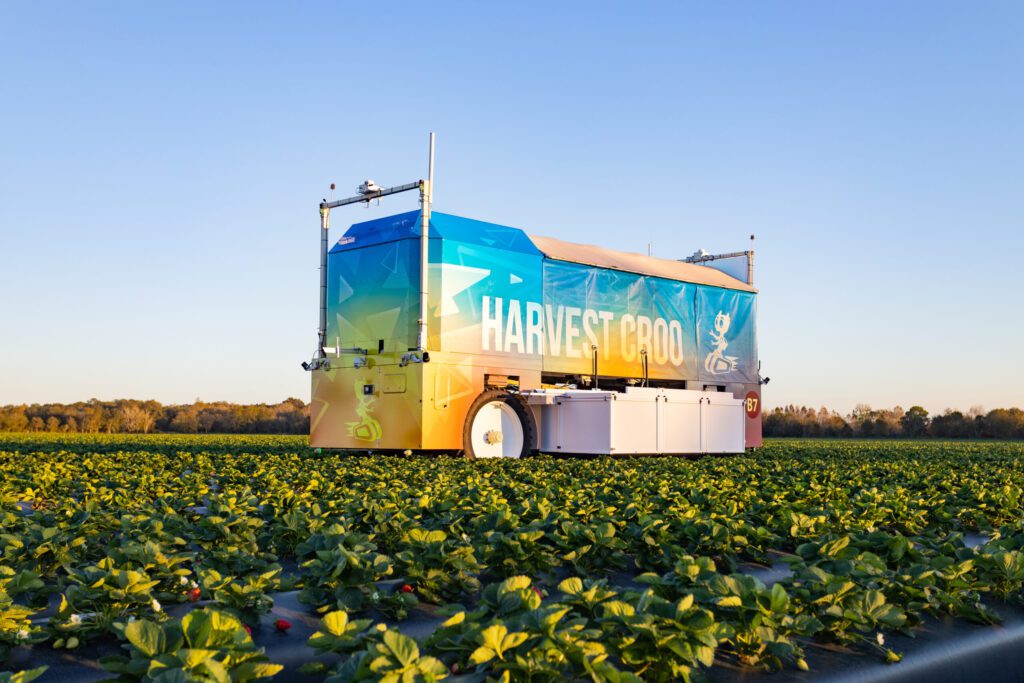Harvest CROO Technology Helps Growers Overcome Challenges
by TERESA SCHIFFER
One of the biggest challenges any type of grower in Florida faces right now is a shortage of manual labor. Finding enough hands to harvest a crop is imperative to prevent massive food waste, but sometimes that is practically impossible to do. If a farmer does manage to round up enough workers to bring in a crop, there is the very real risk that some of them might move on to the next farm before all the work is done. Currently, roughly 25 percent of any strawberry grower’s fields go unpicked altogether each season due to a lack of manual labor available.
Harvest CROO was born of this necessity for reliable labor to harvest crops.
Harvest CROO is a modular robotic vehicle that automates the harvesting, grading, and packing of strawberries. It consists of a 32-foot long transporter that moves through the field on wheels, plucking every ripe berry with robotic hands located underneath the body of the transporter.
Joe McGee is the CEO of Harvest CROO Robotics, the company that developed and fine-tuned this technology. He has been on the company’s board since December 2018 and has been there as the robotic harvester developed from a prototype into a machine that is ready to be deployed in the field for its initial trials. In the past three years, he has seen a number of technical issues resolved to result in a truly effective robotic harvester.
The Harvest CROO makes use of the most innovative, cutting-edge technology available to perform its tasks. It is equipped with a LIDAR system that provides the Harvester with a 360-degree, three-dimensional view of a field, allowing for precision navigation through rows of strawberries while avoiding collisions with people and other obstructions. The machine’s vision system scans each berry and determines whether it is ready for picking. The berry is then further inspected and determined to be suitable for the fresh market, processing, or rejection.
Sixteen independent robots are nestled beneath the transporter carriage, each with six picking hands capable of gingerly removing the ripe fruit from plants. Harvest CROO can be operated at night to take advantage of cooler temperatures during the process, making it easier to harvest and transport the delicate berries without causing any bruising or damage. The harvester can move through one acre in about two and a half hours. Strawberries need to be harvested every three days, so one machine can maintain about 25 acres, returning to each plant every three days.
McGee describes the process of using the Harvest CROO, “We will start at the beginning of the season, we will use a thing called a monopole, and we take the dimensions of the field. We know the spacing of the rows. The Harvester then can go out, we can get a work order and tell it to pick a certain section of the field, and it goes and does that. It picks the strawberries and transfers them. We use a solution that cleans and washes the strawberries. We then pack the strawberries into the clamshell. The solution allows us to hydrocool the berries and also removes pathogens like e. Coli, salmonella, and listeria.”
This hands-free approach to harvesting makes for a much cleaner system. Since the berries are not handled by humans during the process of harvesting, there is no transfer of viruses or other pathogens from them. Another benefit is that by harvesting, sorting, and storing the strawberries on the transporter, bad berries are not being discarded into the field, thereby increasing environmental cleanliness by reducing the amount of waste in the field that could attract mold, rodents, or other pests. Berries that are picked, cleaned, and packaged this way are also showing an extended shelf life.
The Harvest CROO has the potential to increase profit from strawberry production for farmers in numerous ways. In addition to increasing the yield through its careful, thorough harvesting methods, automated harvesting will allow farmers to bring in all their berries in a season, instead of having to helplessly stand by as fields go unpicked due to insufficient manual labor available.
As for concerns that this automation will ultimately put real people out of work, that’s unlikely. Labor shortages are such an issue already, that using this technology will allow farmers to reallocate the workers they have to other tasks, such as the weekly grooming and maintenance of the plants that strawberries require. Placing new plants in the field at the beginning of each season is another job that is not expected to be automated anytime soon. Plus, there will be new positions available for trained technicians to perform maintenance and repairs on Harvesters onsite. Training programs are being established with Florida schools in order to prepare students for these new careers.
For now, the Harvest CROO will only be available for strawberry growers in the U.S., primarily in Florida and California. In the future, there may be adaptations possible that make this type of technology available to a wider range of growers.

